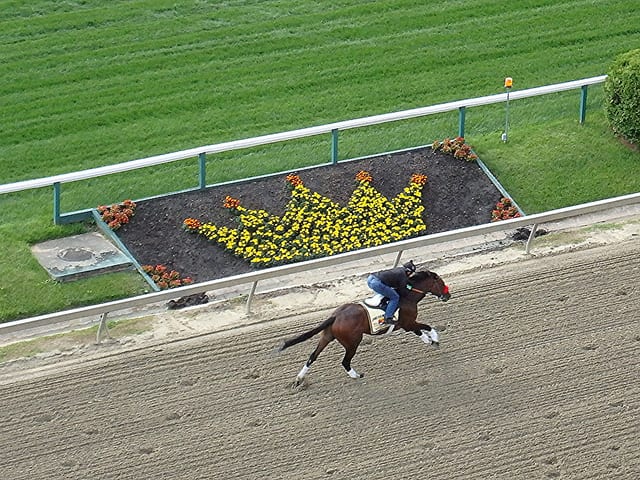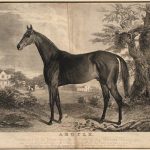FRAVEL: PREAKNESS A “SHOT IN THE ARM” FOR MD. RACING

By Bob Ehalt, story courtesy of The Blood-Horse
As Craig Fravel, along with The Stronach Group and the Maryland Jockey Club, prepares for a renewal of the Preakness Stakes (G1) like none before, it reminds him of a saying made famous by boxer Mike Tyson.
“You go back to that old Mike Tyson quote, ‘Everyone has a plan until they get punched in the face,’ and we’ve been punched in the face regularly,” Fravel said. “But hopefully the public will take notice of the Preakness and what we’re doing and it will be a shot in the arm for Maryland racing amidst all this uncertainty.”
Like the Belmont Stakes Presented by NYRA Bets (G1) and the Kentucky Derby Presented by Woodford Reserve (G1) before it, the 2020 Preakness is taking shape in an unprecedented fashion in a world coping with the COVID-19 pandemic.
Usually the middle jewel in the Triple Crown on the third Saturday in May, the $1 million Preakness will now close out the world-famous series for 3-year-olds Oct. 3 at Pimlico Race Course, but without a crowd of about 130,000, the loud music and reveling of the InfieldFest, or the exciting possibility of some horse continuing its bid to sweep all three Triple Crown races.
“When major cancellations started taking place in March and April, everybody was thinking this would be behind us by the fall and we could wind up with a rational television schedule and life will go on. Obviously, as it evolved, that was far from the case and you had to deal with uncertainties and disease progression on a daily basis,” said Fravel, CEO of racing operations for The Stronach Group, which owns the Maryland Jockey Club, Pimlico, and Laurel Park. “We’ve had good communication with the state and local governments, so even if there was uncertainty we had the ability to get feedback and have input regularly. It wasn’t a matter of making decisions in the dark.”
With the race less than two weeks away, there will be a relatively quiet atmosphere on Preakness Day, when, ironically enough, what could be the best day of racing in Pimlico’s long history is taking shape. Much like Belmont Park for the Belmont Stakes and Churchill Downs for the Kentucky Derby, which were also contested without fans, there will only be handfuls of people at Pimlico, instead of throngs.
At the present time, there’s a target of each owner with a starter in the Preakness and Black-Eyed Susan Stakes (G2) on the Oct. 3 card being allowed to bring a party of 12 to Pimlico and watch the race from stretch-side chalets. Fravel said there would be some flexibility with that number and added plans are in the works to allow the owners of horses in undercard stakes to be on track for those races.
“We want to be respectful of state, county, and city guidelines and make sure masks are worn and there are appropriate levels of social distancing,” Fravel said. “It’s an educational process. We are learning more about it every day.”
- Colonial Downs: Latest jockey and trainer stats
 Which Colonial Downs jockeys and trainers are having a good meet? Who’s doing better than you’d think? Or heating up now? Answers within.
Which Colonial Downs jockeys and trainers are having a good meet? Who’s doing better than you’d think? Or heating up now? Answers within.
All in all, finalizing plans has not been easy when each day seems to bring a new development in dealing with the pandemic, though being last in the Triple Crown rotation allowed TSG to learn from what happened at the other venues.
“The hardest part is not knowing what you will be permitted to do,” Fravel said. “Watching Churchill Downs go through what they did for the Derby helped us a good bit. They were talking about 25-50,000 people and then overnight it came out that there would just be owners and their connections. At that point, we had contingencies for two or three different options and the hardest thing is to avoid committing to a path that will cost you tremendous amounts of money to set up and then you find out that you can’t do that. So we are being careful with our levels of commitments for deposits for infrastructure, but we’re happy with where we are.”
As with the Kentucky Derby and Belmont Stakes, and a meet such as 40 days at Saratoga Race Course, the Preakness generates a huge wagering handle plus a highly lucrative business in items such as ticket sales, concessions, and sponsorships. For both the city of Baltimore, which receives a $52 million economic impact from the Preakness, according to a 2019 study, and the MJC, the loss of hospitality options on-track and revenue from travelers to the city will create a heavy financial burden.
“There’s definitely a financial hit, but there’s some offset in the temporary infrastructure we’ve had in the past to put the event on. Staff levels are reduced. It’s a hit, but there are offsetting savings and we have to make the best of a difficult situation these days,” said Fravel, who added the pandemic has not impacted a state bill passed in May that will pave the way for re-development at Pimlico and Laurel Park.
An initial key issue for Fravel and TSG in planning for the 145th Preakness became finding a new date after May 16 became an impossibility due to coronavirus restrictions. Once Churchill Downs chose Sept. 5 for the Kentucky Derby and the New York Racing Association opted for June 20 for the Belmont Stakes, that became an easier task.
“Ideally, it would be great to be the first, and when you’re the last you’re hoping for Triple Crown contention, but that wasn’t the big factor. By the time we were in a position to make a decision, NYRA had already run the Belmont and the summer schedule (for 3-year-old stakes) with the (TVG.com Haskell Stakes, G1) and (Runhappy Travers Stakes, G1) leading up to the Derby was so crowded that we did not want to jump into that mix,” Fravel said. “We thought we had a decent shot at a good outcome from a racing standpoint, which is always the first criteria, if we get situated between the Kentucky Derby and Breeders’ Cup (Nov. 6-7 at Keeneland). NBC managed to find a window for us on Oct. 3, which is equidistant between the Kentucky Derby and the Breeders’ Cup, and it seemed like the best option.”
Moving from the second leg in the 3-year-old series to the third put TSG and MJC officials in the unusual position of having a rooting interest in the Kentucky Derby, hoping Belmont Stakes winner Tiz the Law could win the Run for the Roses and bring the drama of a Triple Crown sweep to Pimlico. As one would expect from a year as bizarre as 2020, Tiz the Law finished second to Authentic in the Kentucky Derby, ending those hopes.
“When I was watching the Derby I had a momentary sense of deflation,” Fravel said.
- Argyle and Thoroughbred racing in the 1830s
 Connected to Supreme Court justices and governors, the Maryland-bred Argyle became one of the best horses of the 1830s. His story.
Connected to Supreme Court justices and governors, the Maryland-bred Argyle became one of the best horses of the 1830s. His story.
But Fravel’s mood changed when in the days after the Kentucky Derby an increasing number of horses committed to the 1 3/16-mile Preakness, giving it a solid field of contenders for a race that will also award the winner an automatic “Win and You’re In” berth in the Longines Breeders’ Cup Classic (G1). The Bob Baffert-trained Authentic heads the probable starters, a group that also includes Kentucky Derby third-place finisher Mr. Big News. The connections of Tiz the Law have not ruled out heading to Baltimore, and Art Collector and Thousand Words, top Kentucky Derby candidates who missed the Sept. 5 race, are expected to be on hand. Pneumatic, Jesus’ Team, and Liveyourbeastlife are also likely starters, with Dr Post, Mystic Guide, and Happy Saver possibilities to join the field.
“When connections started announcing their plans, there was a good sense that we will have a contentious field. There’s no contender scaring anyone off, which is a decent spot to be in,” said Fravel, who joined TSG in November after spending eight years as the president and CEO of the Breeders’ Cup. “The timing is good because those horses need a race going into the Breeders’ Cup and being at 1 3/16 miles for the final leg as opposed to 1 1/2 miles for the final leg (as in the Belmont Stakes) helps with getting people to examine their options. It will be a terrific horse race and the level of competition (on television) from college football will be reduced because there are less of the major conferences playing.”
Switching its Preakness focus to the fall, the traditional Pimlico spring meet had to be revamped. A six-day meet was put in place, beginning Sept. 24 and ending Oct. 3, with a Preakness card that was expanded to include the Black-Eyed Susan, which is usually held the day before the Preakness, and 10 other Thoroughbred stakes as well as a stakes for Arabians.
The Oct. 1 program will feature the $200,000 Chick Lang Stakes (G3) and two listed stakes and the Oct. 2 lineup includes the $250,000 Pimlico Special Stakes (G3) and nine Claiming Crown preps.
Yet it’s the Preakness card that’s the dazzler with six graded stakes that may bolster wagering after a record of over $99 million was handled in 2019. Aside from the Preakness and the $250,000 Black-Eyed Susan, the card will include the $150,000 Gallorette Stakes (G3T), $150,000 Miss Preakness Stakes (G3), the $200,000 Frank J. De Francis Memorial Dash (G3), the $250,000 Dinner Party Stakes (G2T, formerly the Dixie Stakes) and five listed stakes.
“At the end of the day, the important thing is the quality of the racing,” Fravel said. “If you do it, you want to have a great customer experience and hospitality, but in the world we have we’re happy to focus on great racing.”
Black-Eyed Susan Day traditionally benefits the Susan G. Komen Foundation for breast cancer awareness and Fravel said, “We will have some community-oriented outreach. Since we can’t have the general public in attendance, it will be more of a virtual/digital approach to everything, but we’ll try to cover all the bases.”
Yet in the end, as different as the 145th Preakness may be from the other 144 editions, the bottom line is that the show will go on and the Preakness’ bond with the Triple Crown will remain intact with a field of top 3-year-olds.
“I haven’t been on an airplane since March. I’m going to Maryland Sunday (Sept. 27), so I’m looking forward to getting there and having some crab cakes and getting to actually see in person some people I have been talking to by phone for the last five months,” Fravel said. “What’s happening now is not a growth strategy, but we’re all doing the best we can to hang on.”
LATEST NEWS
















You used “great customer experience and great racing” in the same sentence. Aren’t they mutually exclusive when talking about Pimlico?